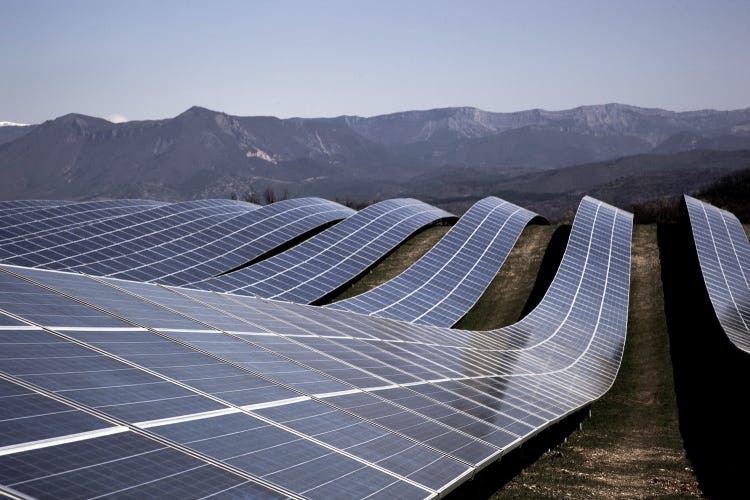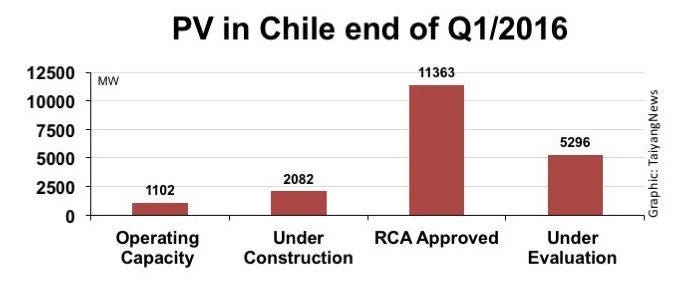
Solar Delivers Cheapest Electricity ‘Ever, Anywhere, By Any Technology’
Half the price of coal!

Chile has just contracted for the cheapest unsubsidized power plant in the world, Bloomberg New Energy Finance (BNEF) reports.
In last week’s energy auction, Chile accepted a bid from Spanish developerSolarpack Corp. Tecnologica for 120 megawatts of solar at the stunning price of $29.10 per megawatt-hour (2.91 cents per kilowatt-hour or kwh). This beats the 2.99 cents/kwh bid Dubai received recently for 800 megawatts. For context, the average residential price for electricity in the United States is 12 cents per kilowatt-hour.
“Solar power delivers cheapest unsubsidised electricity ever, anywhere, by any technology,” BNEF Chair Michael Liebreich said on Twitter after this contract was announced.
Carlos Finat, head of the Chilean Renewable Energies Association (ACERA) told Bloomberg that the auction is “a strong warning sign that the energy business continues on the transition path to renewable power and that companies should adapt quickly to this transition process.” Indeed, in the same auction, the price of coal power was nearly twice as high!
Grid-connected solar power on Chile has quadrupled since 2013. Total installed capacity exceeded 1,000 megawatts this year — the most by far in South America. Another 2,000 megawatts is under construction, and there are over 11,000 megawatts that are “RCA Approved” (i.e. have environmental permits).
The Strategies of Global Warfare: Washington’s Military Design in the Asia-Pacific
China, North Korea as well as Russia are potential targets under Obama’s “Pivot to Asia”, involving the combined threat of missile deployments, naval power and pre-emptive nuclear war. Major military and covert intelligence operations are being undertaken simultaneously in the Middle East, Eastern Europe, sub-Saharan Africa, Central Asia and the Asia Pacific region. The planning of military operations is coordinated with non-conventional forms of warfare including regime change, financial warfare and economic sanctions. All the safeguards of the Cold War era, which categorized the nuclear bomb as “a weapon of last resort”, have been scrapped.
A Thousand Balls of Flame
The US has squandered a fantastic sum of money fattening up its notoriously corrupt defense establishment with various versions of “Star Wars,” but none of that money has been particularly well spent.
Inside the CIA's Secret Drone War
From drone operators to strike victims, we examine the impact of remote-controlled killing and the future of warfare.
Jackson Hole – What Have We Learned?
Chair Yellen’s much-awaited Jackson Hole speech has been touted in the media as suggesting that there will soon be a second rate hike to follow the FOMC’s December 2015 move. However, many have noted that there was actually little, if anything, new in the speech. She did note that there was continued improvement in the economy, especially on the employment front. Some suggest that a possible move in September would hinge upon the release of the next employment number for August, and some of the FOMC participants in attendance noted that all meetings were still live.
However, both Chair Yellen and other FOMC participants were also painfully on message to point out that any policy move would depend upon incoming data, that rates would remain low for some time, and that the subsequent path for further policy moves was more important than the exact starting date. None of this is new, and nothing said should be surprising to most Jackson Hole participants. After all, the purpose of the conference is to discuss policy issues and conceptual policy frameworks and not to serve as a substitute for an actual FOMC meeting. It is out of character for FOMC participants to prejudge actual policy positions and/or to suggest that a policy decision has been made, one way or another, in front of a pending FOMC meeting.
Unlike the press, markets revised only slightly their views on the probability of a rate hike in either September or December. The CME estimate, based upon Fed Funds futures prices, put the probability of a move in September at only 33%, with a 35% chance in November and only a 57% chance for a move in December.
Why might the market’s assessment be so subdued relative to the rhetoric in the press? There are several reasons. First, although FOMC participants suggest that the next employment number will be important, it is also the case that the Committee’s employment objects are close to, if not already, consistent with their statutory mandate. Even there, Governor Powell, in particular, sounded a cautionary note in Jackson Hole. He stated that he believed there was considerable slack remaining in the labor market and that the FOMC could afford to be cautious. Mark him down as a dove, along with Chair Yellen and Governor Brainard.
